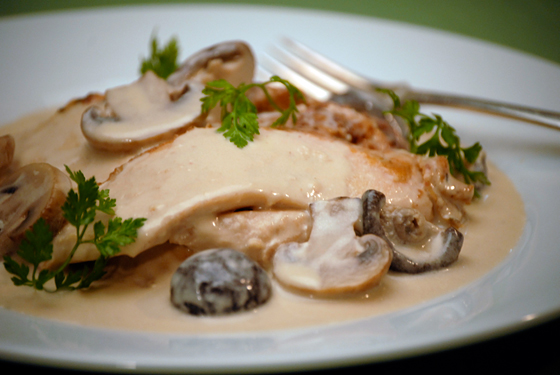Roast Capon with Armagnac-Mushroom Sauce
Episode 126: Fowl Play
Recipe: Roast Capon with Armagnac-Mushroom Sauce
Wine and mushrooms combine with the reduced juices of the chicken and Armagnac to make this dish rich and elegant.
Capons (neutered and fattened chickens) are available during the holiday season in many markets. They are moist, tender, and succulent and well worth their extra cost.
Serves 10
1 pound mushrooms (domestic, wild, or a mixture), cleaned and thinly sliced (about 7 cups)
1 cup dry white vermouth
1 cup homemade Chicken Stock (see recipe below) or low-salt canned chicken broth
1 capon (about 8 pounds)
1 1/4 teaspoons salt
1 1/4 teaspoons freshly ground black pepper
1 teaspoon herbes de Provence
2 tablespoons Armagnac
1 cup heavy cream
1 teaspoon potato starch (see info below), dissolved in 1 tablespoon water
1 tablespoon chopped fresh tarragon
Preheat the oven to 400 degrees.
Put the mushrooms in a saucepan with the vermouth and stock and bring to a boil, then cover, reduce the heat to low, and boil gently for 5 minutes. Set aside.
Season the capon inside and out with 1 teaspoon each of the salt and pepper and the herbes de Provence. Place the bird breast side up in a roasting pan and roast it for 30 minutes. Turn it over and roast for 1 hour. Finally, turn the capon onto its back again and roast it for 10 more minutes. (An instant-read thermometer inserted into the joint connecting a thigh and drumstick should register about 160 degrees.) Transfer the capon to an ovenproof platter and keep it warm in a 160-degree oven. (If you only have one oven, turn off the oven and leave the door open for about 5 minutes, then return the capon to the oven to keep warm.)
Skim off as much fat as possible from the drippings in the roasting pan. Pour the juices from the mushrooms into the pan and heat over high heat for a few seconds, stirring to melt the solidified juices, then pour the resulting glaze through a strainer set over the mushrooms. Add the cream and Armagnac to the mushroom mixture, bring to a boil, and stir in the dissolved potato starch. Mix in the remaining 1/4 teaspoon each salt and pepper and the tarragon.
Carve the capon and serve it with the sauce.
CHICKEN STOCK
Makes 3 quarts
It takes very little work to make your own stock; mostly it is a matter of being at home for the several hours it takes to cook. A flavorful money saver that is practically fat- and salt-free, homemade stock can be frozen in small quantities and used as needed.
Chicken backs and necks are available at most supermarkets. If you don’t see them, ask the butcher to set aside some for you. I also make stock from the bones of roasted chicken or turkey.
4 pounds chicken bones (necks, backs, wings, etc.), skinless or with as little skin as possible
6 quarts cold water
1 large onion (about 8 ounces), quartered
1 tablespoon herbes de Provence
12 whole cloves
4 bay leaves
1 tablespoon dark soy sauce (optional)
Combine the bones and water in a large stockpot and bring to a boil over high heat. Reduce the heat and boil gently for 30 minutes. Most of the fat and impurities will rise to the surface; skim off as much of them as you can and discard them.
Add the onion, herbes de Provence, cloves, bay leaves, and soy sauce, if using, return to a boil, and boil gently for 2 1/2 hours. Strain the stock through a fine strainer or a colander lined with dampened paper towels. Allow to cool.
Remove the surface fat and refrigerate the stock for up to 5 days, or pour into containers and freeze.
POTATO STARCH
I often use a “pure starch” — generally potato starch or arrowroot — to finish a sauce and give it a bit of viscosity. If nothing else is available, you can substitute cornstarch, but it tends to make a sauce gooey and gelatinous. I prefer potato starch, which is made from steamed potatoes that are dried and ground. Potato starch is gluten-free and sometimes appears in baked goods, particularly Jewish-Passover specialties. Inexpensive and available in 1-pound packages, it can be found in the Kosher section of many supermarkets and in Asian specialty food shops (it is also used in Japanese cooking). Arrowroot, on the other hand, comes in very small containers and is very expensive.
All of these starches are used in the same way: they are diluted with a little cold liquid — water, wine, or stock — and then stirred into a hot sauce. The starch thickens the sauce on contact and then it is usually brought to a boil.
Copyright © 2011 by Jacques Pépin. Used by permission of Houghton Mifflin Harcourt. All rights reserved.











